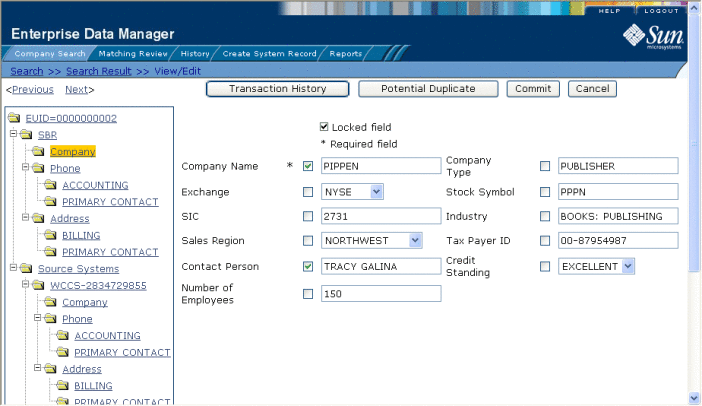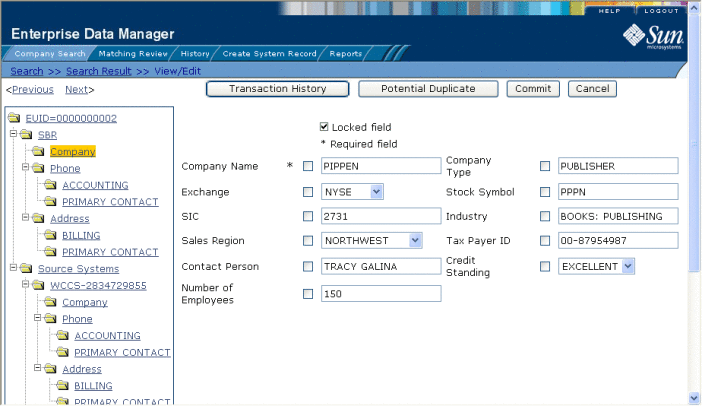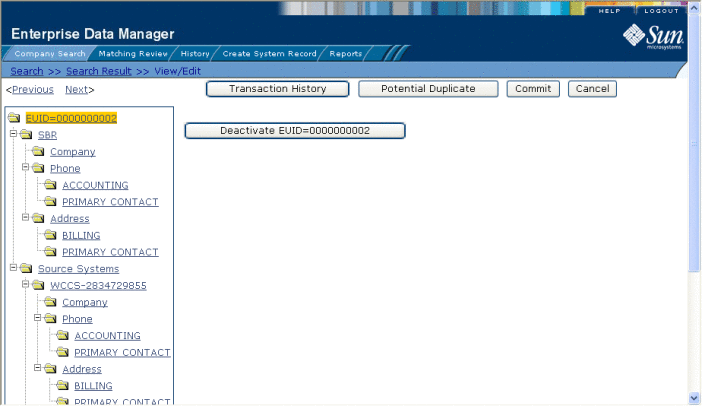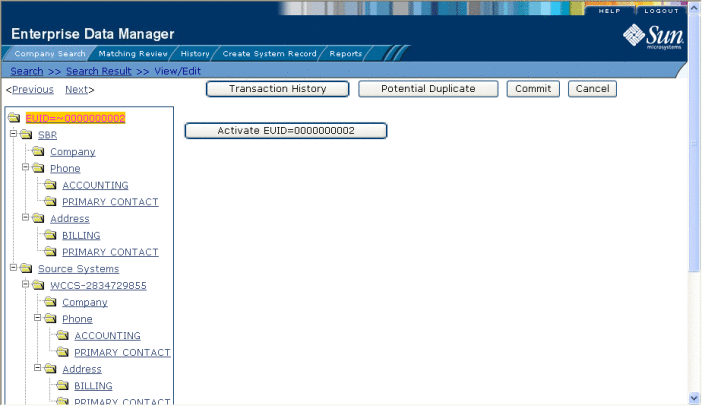Modifying Profile Information on the EDM
Once an object profile has been added to the master index application, you can modify information about that object, update the object's single best record, add system records to the profile, or change the status of a system record or object profile. If you make any of these modifications, the survivor calculator determines what changes, if any, should be made to the SBR. You can only modify the SBR directly if you have overwrite permissions.
Perform any of the following tasks to update profile information.
Modifying Parent Object Information
If the parent object information for an object profile changes, you can update the information in either the SBR or the affected system record. If you update the system record, then the survivor calculator determines what changes, if any, should be made to the SBR. You must have overwrite permissions to update the SBR directly.
Figure 35 View/Edit Page - Parent Object

 To Modify Parent Object Information
To Modify Parent Object Information
-
Using one of the search methods described in Searching for Object Profiles on the EDM, display the object profile you want to modify on the View/Edit page.
-
Do one of the following:
-
Modify the fields in the right portion of the page.
-
If you are working in the SBR, make sure the overwrite check box to the left of the field is selected for each field you modify.
-
When you are done modifying information, click Commit.
The page refreshes, and, if you modified a system record, the SBR is recalculated based on the new information.
Adding a Child Object on the EDM
If additional information becomes available about an object, you might need to add a new child object to the object profile. For example, if additional address information becomes available, you might need to add a new address record to the SBR or to the affected system record.
Figure 36 View/Edit Page - Child Objects

 To Add a Child Object
To Add a Child Object
-
Using one of the search methods described in Searching for Object Profiles on the EDM, display the object profile you want to modify on the View/Edit page.
-
Do one of the following:
-
To add the child object to the SBR, select the child object type under SBR in the EUID tree in the left portion of the View/Edit page.
For example, to add an address record, select Address.
-
To add the child object to a system record, select the child object type under that system record in the EUID tree in the left portion of the View/Edit page.
-
-
Enter the new information in the fields in the right portion of the page.
-
In the lower left portion of the page, click Add child_type (where child_type is the type of child object you are adding).
-
Click Commit.
The page refreshes, and, if you modified a system record, the SBR is recalculated based on the new information.
Note –If you added the information to the SBR, all fields in the new record are automatically locked, and will not be updated by incoming system messages. If all fields in the child object are unlocked, that object is removed from the SBR.
Modifying a Child Object on the EDM
If information about an object changes, you might need to modify information for an existing child object.
 To Modify a Child Object
To Modify a Child Object
-
Using one of the search methods described in Searching for Object Profiles on the EDM, display the object profile you want to modify on the View/Edit page.
-
Do one of the following:
-
Modify the fields in the right portion of the page.
-
If you are working in the SBR, make sure the overwrite check box to the left of the field is selected for each field you modify.
-
When you are done modifying information, click Commit.
The page refreshes, and, if you modified a system record, the SBR is recalculated based on the new information.
Deleting a Child Object on the EDM
If a child object is entered incorrectly or becomes obsolete, you can delete the object from the affected system record. Child objects can only be deleted from the SBR if they were added directly to the SBR. Deleting a child object cannot be undone.
 To Delete a Child Object
To Delete a Child Object
-
Using one of the search methods described in Searching for Object Profiles on the EDM, display the object profile you want to modify on the View/Edit page.
-
Under the affected system record in the EUID tree in the left portion of the View/Edit page, select the child object you want to remove.
-
Do one of the following:
-
If the child object is in the SBR, deselect the overwrite check box for each field in the child object.
Note –This can only be done if the child object was added directly to the SBR.
-
Click Commit.
The page refreshes, and the SBR is recalculated based on the new information.
Updating the Single Best Record Directly on the EDM
Unless a field in an SBR is locked for overwrite, the value for that field is recalculated by the survivor calculator each time the object profile is updated. If you determine that a value in the SBR is the most accurate data and should not be updated, you can lock the field. If you unlock a locked field, the value of that field is automatically recalculated by the survivor calculator as soon as the unlock action is committed.
Locking an SBR Field
When you lock a field in an SBR, that field can only be updated through the EDM by a user who has overwrite permissions. Locking a field in the SBR removes the survivor calculator from the update process for that field and any updates made to or by system records will not update the locked fields in the SBR.
Figure 37 Locked fields in an SBR

 To Lock a Field in the SBR
To Lock a Field in the SBR
-
Using one of the search methods described in Searching for Object Profiles on the EDM, display the object profile containing the field you want to lock on the View/Edit page.
-
In the EUID tree, select the component in the SBR containing the field you want to lock.
-
If necessary, update the value of the field to be locked.
-
Select the overwrite check box to the left of the field.
-
Click Commit.
The field is now locked and cannot be edited by updates to system records until the lock is removed.
Unlocking an SBR Field
Once you unlock a field for overwrite in an SBR, the SBR is recalculated by the survivor calculator and the field can be updated by changes made to system records. If you added a child object to an SBR and then unlock all fields in the new object, that object is removed from the SBR by the survivor calculator.
Figure 38 Unlocked Fields in an SBR

 To Unlock an SBR Field
To Unlock an SBR Field
-
Using one of the search methods described in Searching for Object Profiles on the EDM, display the object profile containing the field you want to unlock on the View/Edit page.
-
In the EUID tree, select the object in the SBR that contains the field you want to unlock.
-
Clear the overwrite check box to the left of the field you want to unlock.
-
Click Commit.
The field is now unlocked and can be edited by updates to system records. The SBR is recalculated by the survivor calculator.
Adding a System Record to an Object Profile on the EDM
If an object has local IDs in addition to those already recorded in the master index application, you can add the local IDs to the object’s profile by adding a system record to the profile. To add a local ID to an object profile, you need to specify information such as the system that assigned the local ID, certain parent-object information, and the local ID itself. When you add a system record to an object profile, the survivor calculator determines what changes, if any, should be made to the SBR.
You cannot add a new local ID and system pair to an object profile if that same local ID and system pair already exists in another object profile.
Figure 39 View/Edit Page - System Records

 To Add a System Record to an Object Profile
To Add a System Record to an Object Profile
-
Using one of the search methods described in Searching for Object Profiles on the EDM, display the object profile you want to modify on the View/Edit page.
-
In the EUID tree in the left portion of the page, select Source Systems.
-
FollowStep 2: Specify a System and Local ID throughStep 5: Save the Object Profile.
When you commit the changes, the page refreshes and the SBR is recalculated based on the new information.
Note –You only need to enter required fields in order to save the new system record. Required fields are indicated by an asterisk (*).
Deactivating a Profile or System Record on the EDM
If an object profile or system record is no longer active, you cannot delete the profile or record, but you can deactivate it. Once you deactivate a record, you can reactivate it if needed. Deactivating an object profile deactivates all system records associated with that profile and removes the potential duplicate listings for that profile. If you deactivate a system record, the survivor calculator determines what changes, if any, should be made to the SBR.
Deactivating an Object Profile
Deactivated profiles cannot be modified, and in some cases, cannot be viewed. If you deactivate a profile in error, you can reactivate it if needed.
Figure 40 View/Edit Page - Deactivate

 To Deactivate an Object Profile
To Deactivate an Object Profile
-
Using one of the search methods described in Searching for Object Profiles on the EDM, display the object profile you want to update on the View/Edit page.
-
In the EUID tree in the left portion of the page, highlight the EUID number of the object profile.
-
Click Deactivate EUID=EUID_number, where EUID_number is the EUID of the object profile to deactivate.
-
In the upper right section of the page, click Commit.
The profile is deactivated in the database and the EUID appears in fuchsia with a tilde (~) next to it.
Deactivating a System Record
If an existing local ID for an object becomes obsolete, you can deactivate the system record with that local ID for the object profile. An object profile must have at least one active local ID; if you deactivate an object’s last active system record, the entire profile is deactivated. When you deactivate a system record from an object profile, the survivor calculator determines what changes, if any, should be made to the SBR.
 To Deactivate a System Record
To Deactivate a System Record
-
Using one of the search methods described in Searching for Object Profiles on the EDM, display the object profile you want to modify on the View/Edit page.
-
In the EUID tree in the left portion of the page, expand Source Systems, and then select the system and local ID of the system record you want to deactivate.
-
Click Deactivate system-ID, where system is the system name and ID is the local ID number for the system record you want to deactivate.
-
Click Commit.
The page refreshes and the SBR is recalculated based on the new information.
Reactivating a Profile or System Record on the EDM
Once an object profile or system record is deactivated, you can reactivate it if needed. Reactivating a profile causes the potential duplicates for the profile to be recalculated. Reactivating a system record causes the SBR to be recalculated.
Reactivating an Object Profile
If an object profile is deactivated in error or becomes active again, you can reactivate that profile. Reactivating a profile returns the profile to its status just prior to when it was deactivated.
Note –
When you reactivate an object profile, all system records associated with that profile are changed to active status, regardless of their prior status. Review each system record to verify that its status is correct after the reactivation.
Figure 41 View/Edit Page - Reactivate

 To Reactivate an Object Profile
To Reactivate an Object Profile
-
Using one of the search methods described in Searching for Object Profiles on the EDM, display the object profile you want to update on the View/Edit page.
-
In the EUID tree in the left portion of the page, highlight the EUID number of the object profile.
-
Click Activate EUID=EUID_number, where EUID_number is the EUID of the object profile to deactivate.
-
In the upper right section of the page, click Commit.
The profile is reactivated in the database, the EUID typeface changes from fuchsia to black, and the tilde (~) is removed.
Reactivating a System Record
If a system record was deactivated in error or is no longer inactive, you can easily reactivate the system record.
 To Reactivate a System Record
To Reactivate a System Record
-
Using one of the search methods described in Searching for Object Profiles on the EDM, display the object profile you want to modify on the View/Edit page.
-
In the EUID tree in the left portion of the page, expand Source Systems, and then select the system and local ID of the system record you want to reactivate.
-
Click Activate system-ID, where system is the system name and ID is the local ID number for the system record you want to reactivate.
-
Click Commit.
The page refreshes and the SBR is recalculated based on the new information.
- © 2010, Oracle Corporation and/or its affiliates
